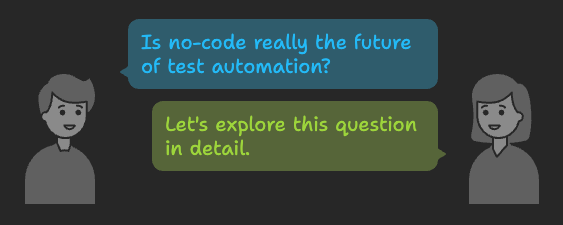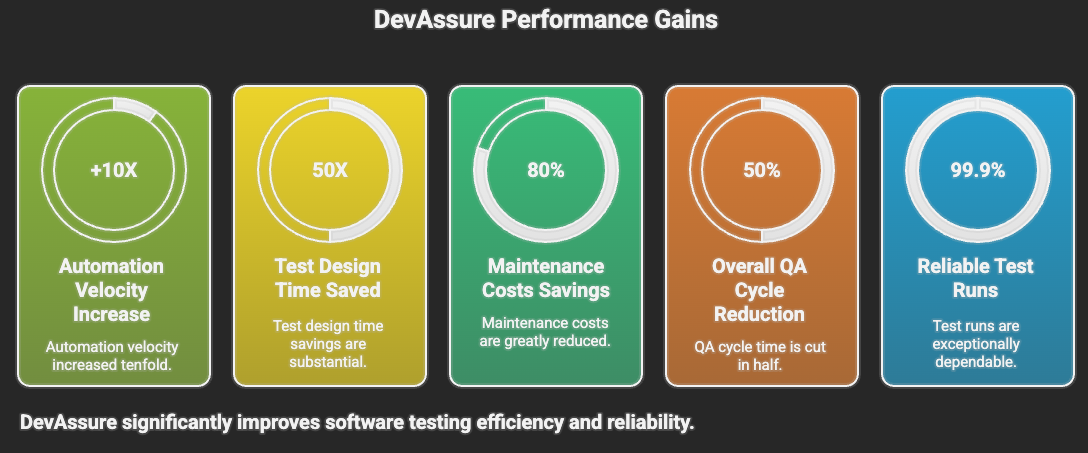Is No-Code Really the Future of Test Automation?
The complexity of automating multi-platform applications (web, mobile, APIs, data validations, etc.) has increased significantly. An end to end test automation solution that can handle all these complexities is the need of the hour. Traditional test automation tools require extensive coding knowledge and can be time-consuming to set up and maintain.
Rise of no-code test automation tools promises to simplify the process, making it accessible to a broader audience.

What is No-Code Test Automation?
No code test automation refers to the use of tools and platforms that allow users to create automated tests without writing any code. Broadly there are 3 categories of no-code test automation tools:
- Visual Test Automation Tools: These tools provide a drag-and-drop interface to create test cases. Users can select elements on the screen and define actions and assertions without writing code.
- Record and Playback Tools: These tools allow users to record their interactions with the application and then play them back as automated tests.
- AI-Powered Test Automation Tools: These tools leverage artificial intelligence to automatically generate test cases based on user behavior and application usage patterns.
Instead of writing:
page.get_by_role("button", name="Login").click()
A tester might simply say: “Click the Login button.”
Instead of coding locators, they can record actions in a browser and reuse them as test steps.
The value proposition is clear: faster test creation, lower skill barrier, and easier maintenance.
Why No-Code Looks Like the Future
- Accessibility: No-code tools democratize test automation, allowing non-technical team members to contribute to the testing process. This can lead to a more collaborative and inclusive approach to quality assurance.
- Speed: No-code tools can significantly reduce the time required to create and maintain automated tests. This allows teams to respond more quickly to changes in the application and deliver updates faster.
- Cost-Effectiveness: By reducing the need for specialized coding skills, no-code test automation can lower the overall cost of testing. This is particularly beneficial for small and medium-sized businesses with limited resources.
- Flexibility: No-code tools often come with pre-built integrations and templates, making it easier to adapt to different testing scenarios and requirements.
- Reduced Maintenance: No-code tools often handle updates and changes to the application automatically, reducing the maintenance burden on testers.

The hidden challenges of No-Code Test Automation
For all the promises, no-code is not without limits. Here are some challenges to consider:
- Complex real-world scenarios: No-code tools may struggle to handle complex test scenarios that require advanced logic or customizations. This can limit their effectiveness in certain situations.
- Integration limitations: No-code tools may not integrate seamlessly with all development and testing tools, leading to potential workflow disruptions.
- Scalability: As applications grow in complexity, no-code solutions may face challenges in scaling to meet the demands of larger test suites.
- Vendor lock-in: Relying on a specific no-code tool can lead to vendor lock-in, making it difficult to switch to another solution if needed.
- Debugging and troubleshooting: When tests fail, it can be challenging to identify and resolve issues without access to the underlying code.
- Expensive licensing: Some no-code tools come with high licensing fees, which can be a barrier for smaller teams or organizations.
The Future of No-Code Test Automation
Will no-code test automation become the dominant approach in the future?
While it has the potential to revolutionize the testing landscape, it is unlikely to completely replace traditional coding-based approaches. Instead, we can expect a hybrid approach where no-code tools are used for simpler test cases, while more complex scenarios are handled by skilled testers using code-based solutions.
As no-code tools continue to evolve, we can expect to see improvements in their capabilities, making them more versatile and powerful. Additionally, advancements in AI and machine learning may further enhance the effectiveness of no-code test automation. Automation engineers will shift from writing boilerplate scripts to solving harder problems: optimizing coverage, handling edge cases, and driving in-sprint automation.
No-code is not the end of coding, but the end of coding everything.
The Pragmatic Path Forward
To leverage the benefits of no-code test automation while mitigating its challenges, organizations should consider the following strategies:
- Use no-code for regression and happy paths - Let AI and visual workflows cover the 70 - 80% of straightforward tests.
- Keep extensibility for edge cases - Ensure the platform allows script injection or external libraries for complex workflows.
- Focus on collaboration, not replacement - No-code should empower QA and product teams, not alienate engineers.
- Measure ROI continuously - Compare maintenance costs, execution success rates, and team adoption before going all-in.
Conclusion
So, is no-code the future of test automation? Yes—but not in the absolute sense.
The real future is AI + No-Code + Extensible Code working together:
- AI generates
- No-code accelerates
- Code extends
Organizations that embrace this hybrid future will deliver software faster, with fewer bugs, and with testing truly democratized across teams. Those that chase extremes—either “all code” or ��“all no-code”—will find themselves stuck with inefficiencies.
The next decade won’t be about “scriptless” automation, but about smarter, agentic automation that blends people, AI, and code.
🚀 See how DevAssure accelerates test automation, improves coverage, and reduces QA effort.
Ready to transform your testing process?
